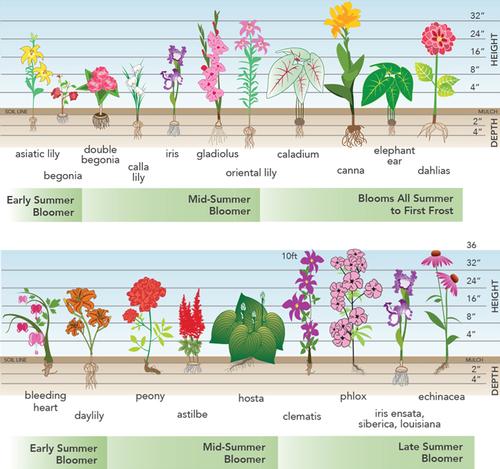When and Where to Plant Summer Bulbs
Every yard and garden can benefit from the beauty of spring-planted, summer-blooming bulbs. Wonderful on their own, they are also good companions for annuals, perennials, shrubs and ground covers. Many of them grow well in containers, too.
Plan for a Succession of Blooms
Each type of flower bulb blooms on a different schedule. Asiatic lilies, for example, flower in early summer. Pineapple lilies and canna lilies bloom in midsummer. Dahlias bloom right through the fall.
When you know what to expect from these summer bulbs, you can plan for a succession of color all season long. For a more detailed guide to bloom times, check out our Bloom Time Planning Guide for Spring and Summer Flower Bulbs.

Know Your Hardiness Zone
How do you know which plants will be winter hardy in your area? The USDA has divided the US into climate zones based on average minimum winter temperatures. These climate zones range from zone 12 (tropical) to zone 2 (arctic). To find your hardiness zone, click HERE.
All plants and bulbs are given a hardiness rating that lets you know how much winter cold they will tolerate. Many summer-blooming bulbs, such as caladiums, canna lilies and elephant ears, are tropical plants that can't survive cold winters.
Gardeners in northern areas can still enjoy growing these tender bulbs during the summer months. Simply treat them as annuals (buying new bulbs each spring), or bring the bulbs indoors before freezing temperatures arrive in the fall.

When to Plant Summer Bulbs
Summer bulbs should be planted in mid to late spring, after all danger of frost has passed. Night time temperatures should be averaging at least 60°F, and soil temperatures should be 65 to 70°F. Bulbs such as caladiums and elephant ears will not grow in cool soil, so it's best to wait an extra two weeks before planting them.
Gardeners in southern areas (dark purple) should plant January-March
Gardeners in central areas (medium purple) should plant March-May
Gardeners in northern areas (light purple) should plant April-June

Sunlight and Soil Requirements
Most plants, including summer bulbs, have preferences for how much sun or shade they want. When you're selecting plants for your garden, pay attention to these recommendations. They are usually noted in the descriptions and also on the packaging.
Before planting, take the time to observe your yard and garden with an eye to how much sun each area receives. Consider the shadows of trees and buildings, and remember that the angle of the sun gets lower as the summer progresses. Then match your plants with a location that will give them the best chance for success.
FULL SUN areas get 6 or more hours of sunlight.
PART SUN areas get 4-6 hours of sunlight per day.
SHADE areas receive less than 4 hours of sunlight per day.
Most plants prefer growing in loose, well-drained soil. If your soil is compacted, sandy or heavy, you can improve the texture over time by adding compost and peat moss. Avoid planting in soggy areas. Very few plants will tolerate wet feet.


